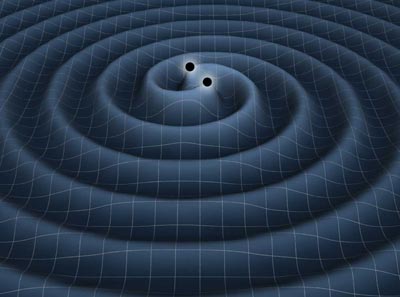Scientists in California have proposed a new type of gravitational-wave detector that is immune to laser noise – a problem that adds to the expense of current detector designs. The researchers believe that their proposal – a modified form of an atom interferometer – would be cheaper and easier to implement in space than current laser interferometers.
Gravitational waves are tiny perturbations in the curvature of space–time that arise from accelerating masses – according to Einstein's general theory of relativity. The first hint that the waves exist was spotted in 1974 as a gradual decrease of the orbital period of the pulsar PSR B1913+16, which circles a neutron star. However, no-one has directly detected a gravitational wave. Such a discovery would provide confirmation of general relativity and also open a new field of gravitational-wave astronomy, in which distant objects could be studied by the waves they emit.
Huge and costly
The conventional way to try to detect gravitational waves involves a long-baseline laser interferometer. A passing gravitational wave should cause the pathlengths of the two beams to change slightly, causing a shift in the interference fringes when the beams are recombined.None of these detectors have yet succeeded in detecting a gravitational wave; so to increase sensitivity, astronomers need to put detectors in space. Constructing a traditional L-shaped interferometer in outer space would require three satellites, which poses severe technological and financial challenges.
The proposed Laser Interferometer Space Antenna (LISA) project, originally scheduled for launch in 2015, has been revised because of its high cost.
A single-baseline interferometer, which measures the change in length of a single path by interfering the emitted and reflected waves in a mirror cavity, would require just two satellites. But in this set-up it would be difficult to distinguish changes in pathlength from random fluctuations in the frequency of the laser – a phenomenon called phase noise.
Atom interferometers were proposed in the late 1980s and first built in the early 1990s by physicists including Mark Kasevich and Steven Chu at Stanford University. Instead of measuring the difference in phase between two beams of light, an atom interferometer measures the change in the phase of a matter wave made of atoms in a superposition of quantum states.
An atom interferometer can be created by repeatedly exciting and de-exciting one half of the wave function using a laser while holding the other half in the ground state. The wavelength of an atom shortens when the atom is in its excited state, creating a phase shift between the two halves of the wave function that depends on how long the first half has spent in the excited state.
In this latest work, Kasevich and colleagues, led by theoretical physicist Peter Graham at Stanford University, propose placing two atom interferometers a long distance apart and using the same pulsed lasers – one originating at one interferometer, one at the other – to excite and de-excite the atoms in both interferometers. The time each atom spends in the excited state depends on the travel time of the laser pulses between the two atom interferometers. "Each atom cloud is like a stopwatch," explains Kasevich. "When the laser pulse comes from one direction, it starts the clock. When it comes from the other direction, it stops it."Each atom cloud is like a stopwatch
Mark Kasevich, Stanford University
Putting atoms to work
If the length of the baseline between the interferometers is constant, the atoms at both interferometers will accumulate the same phase shift. But if one interferometer accelerates relative to the other, the time between excitation and de-excitation of half the wave function will differ at the two locations and the atoms will accumulate a different relative phase shift. The same laser pulses excite and de-excite the atoms in both interferometers, so the laser-phase noise affects both atoms in the same way and does not affect the difference between the phase shifts detected at the two interferometers. "The light is just acting as the gate to turn off and on the clock," says Kasevich. "The atom is doing all the hard work."Gravitational-wave expert B S Sathyaprakash of Cardiff University is cautiously optimistic. "The scheme is obviously very exciting," he says. "But I think the big question is what kind of technology is required in space to run this thing for three to five years? I'm not saying anything negative or positive, but I would like to see numbers." In an attempt to provide these, the Stanford team is currently planning to build a prototype in the laboratory to ascertain whether or not there are any unforeseen technical challenges with the proposal.
-------------------------
*Leave a comments, questions or even a suggestions below this post. Your expressions are always welcomed.











0 comments:
Post a Comment